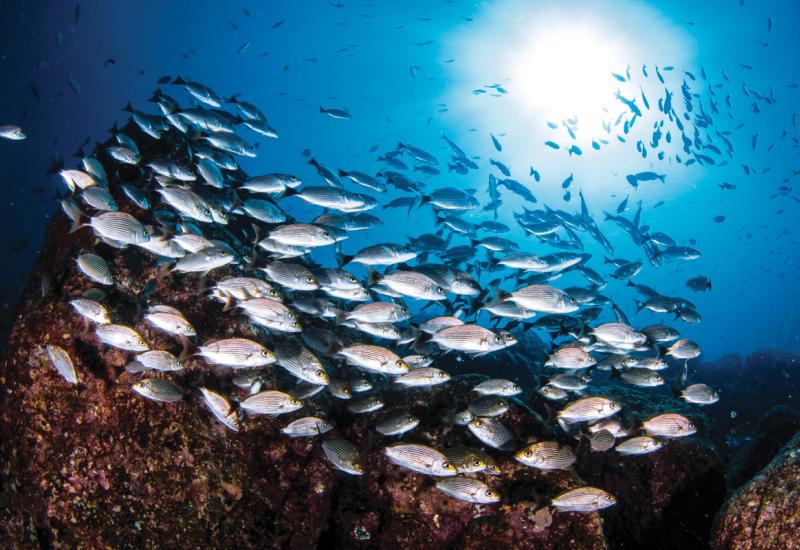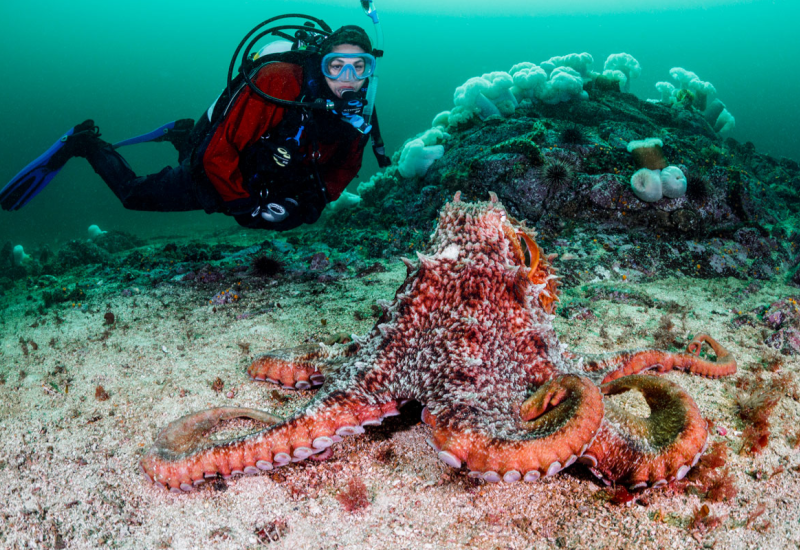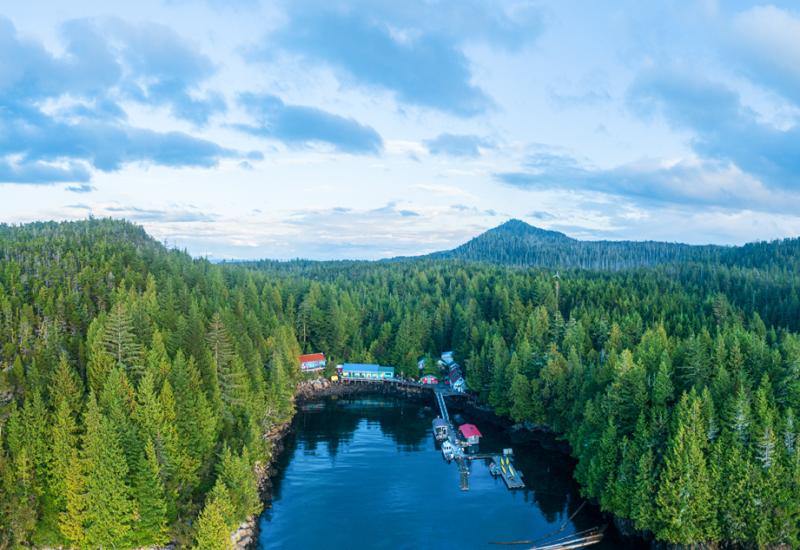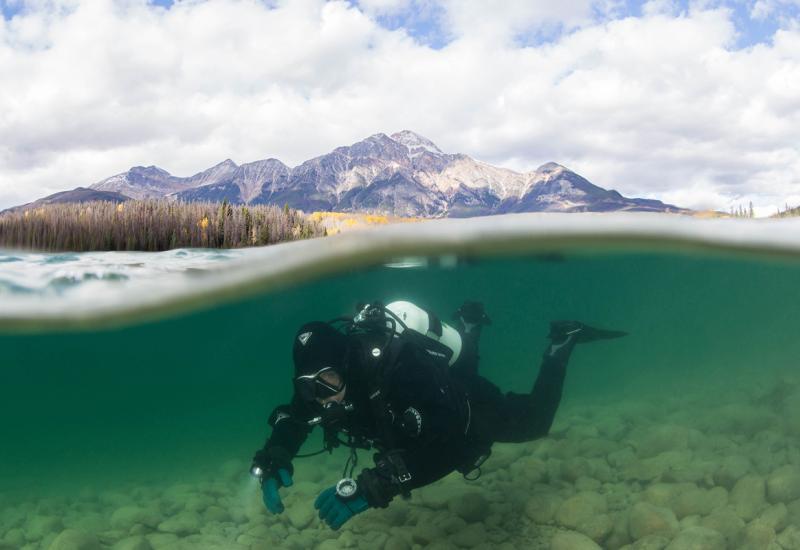Vancouver, B.C.
February 2008
By Marli Wakeling
Ask Vancouver divers where they learned to dive and most will answer, "Whytecliff Park." It's nestled at the far edge of the affluent suburb of West Vancouver, near the rugged shoreline of Horseshoe Bay. In 1993, the Canadian government designated Whytecliff as the country's first Marine Protected Area. Boats are not permitted, nor is the taking of marine life. The result is a rich ecosystem with more than 200 marine animal species residing just offshore from one of the city's wealthiest neighborhoods.
While many divers have heard about the glorious diving on Vancouver Island, surprisingly few know that the city of Vancouver, on the province's mainland, offers a variety of dive sites for both novices and techies right in its own backyard. Howe Sound begins at the northwestern edge of metropolitan Vancouver and makes a great destination for a boat charter.
This diverse, vibrant city--and future home of the 2010 Winter Olympics--may well be the world's most active. With its mild climate and proximity to the Pacific Ocean and Coast Mountains, it's not surprising to find Vancouverites kayaking, skiing, cycling, strolling along forest trails--and yes, diving--all in one weekend.
Whytecliff Park:
Where the Love Affair Begins
There are three choices of sites within the park boundary--Whyte Islet, the Day Marker and The Cut--so a multiple-dive day with a picnic lunch can be a great way to spend a weekend afternoon. Or try a midweek dive escape to beat the crowds that fill Whytecliff Park on the weekends. Most divers gear up at the top of the hill and make their way down the steep path to the shoreline.
Whyte Islet is on the bay's south end. The Islet's northern side consists of a series of rocky ledges that plunge to depths of 100 feet. The best dive strategy on the weekends is snorkeling out past the novice divers to begin your descent. Purple sea stars plaster the rocks in the shallows, and sea squirts and sea peaches share space with calcareous tube worms and lemon peel nudibranchs. As you reach Whyte Islet's western tip, beware. The currents here can be strong at times. If conditions permit, explore this area, which juts into the ocean to a depth of 90 feet. A large field of majestic white plumose anemones explodes from the rock face. Cloud sponges with ruffled lobes start at 70 feet--look for squat lobsters and juvenile rockfish hiding within. Then, work your way back to shore across the sandy bay and look for flatfish and white-spotted greenling. On night dives, look for the elusive stubby squid.
The Day Marker on the bay's northwestern edge is another option for divers. It warns boaters of a rocky reef that's hidden at high tide. In the shallows, schools of shiner perch shimmer. Once you reach the wall at the south end, huge fields of white plumose anemones abound. Check in the crannies for sailfin sculpins and giant Pacific octopus. You'll find outcroppings covered with zoanthids, and rockfish lazily drift by, unafraid. Some huge lingcod also make their home here. But don't taunt them in spring when they're guarding their eggs--they've been known to charge divers.
The Cut is for physically fit, advanced divers. From the sheltered lookout, follow the winding trail to the narrow entrance between two rock faces. The Cut has a steep wall with large chimney and boot sponges, lingcod, kelp greenling, and if you look carefully, red Irish lords and giant Pacific octopus. You'll also find an assortment of discarded bottles, cans and various castoffs. As these containers may be some critter's real estate, please leave them in place. Depths here can reach far beyond sport-diving limits, so watch your computer and gauges.
Howe Sound:
Vancouver's Diving Playground
This inlet offers divers a variety of underwater terrain, but shore access is limited and many sites are accessible only by boat (charters are offered by many local dive operators). Extreme walls, rocky pinnacles, ledges, colorful invertebrate life and amusing marine mammals keep local divers in the chilly waters year-round, provided they're adequately protected with a drysuit.
One of Howe Sound's most popular areas is Bowyer Island for its easy diving and variety of terrain and marine life. Mooring buoys have been installed by local divers on two sites to provide easy access and reduce damage from anchors. There are three main sites to dive on Bowyer: North Pinnacle, South Reef and East Wall. North Pinnacle offers tremendous variety. Cute harbor seal pups will often surprise you at the bottom of the mooring line, wanting to play--or chew on your fins. As you work your way around the pinnacle, look for octopus dens, grunt sculpins and pink-gilled nudibranchs. At the pinnacle's base, on the sand flats, look for giant nudibranchs attacking tube-dwelling anemones or nearly invisible shrimp on delicate sea pens.
South Reef has many choices for divers, from a steep wall, plunging past 100 feet, to a rocky reef and shallow sand patches. Small cloud sponges on the wall to the south of the buoy hold decorated warbonnets within their folds. An octopus resides under an old barbecue grate while a timid wolf eel peeks out from his den beneath a boulder. Orange and brown cup corals cling to the rocks, and masses of brittle stars blanket the rubble bottom. On your ascent up the mooring line, look for nudibranchs, juvenile scallops and small anemones that have made it their home.
A steep wall on Bowyer's east side must be done as a live-boat dive, as the sheer face and depths prohibit anchoring. Start about a third of the way down from the north end, where harbor seals will warily watch you from shore as you descend. In the shallows, look for eel-like gunnels and orange-spotted Cockerel's nudibranchs. Depths here go far beyond sport-diving limits, but at 70 feet, you'll encounter cloud and boot sponges housing dock shrimp, galathaeid crabs and juvenile rockfish. Crimson anemones hide Kincaid's shrimp, and in late summer and fall, large lion's mane jellyfish can be found, so be aware of your surroundings. Then, look behind you. You may see a friendly Vancouverite--a curious harbor seal pup--looking back.
InDepth
Getting Around: Whytecliff Park and Howe Sound, a three-hour drive north of Seattle on Interstate 5 and Highway 99, are located in the suburb of West Vancouver near Horseshoe Bay. West Vancouver is accessed from Vancouver's downtown by the Lions Gate Bridge and Highway 99, or from the east by Highway 1 and the Ironworkers Memorial Bridge. At Whytecliff Park there are showers, a concession stand, picnic tables, water for rinsing gear and an access ramp for divers with physical challenges. Boat charters for Howe Sound depart from Horseshoe Bay.
Dive Conditions: The water here can be chilly--43 to 52 degrees. Dry suits are de rigueur in the winter, but most divers wear them year-round. In the summer, hardy divers can get by with 7mm wetsuits. Visibility varies greatly, and can depend on the tidal exchange, algal blooms and wind. Conditions can change quickly. In winter, visibility can reach 70 feet, while in summer it ranges from 10 to 50 feet. Tidal variations can range up to 16 feet in spring and fall. Dive around high slack tide for best visibility, and enter the water around an hour before the slack to ensure low current.
Dive Outfitters, Charters and Education Centers: Adventure II Dive Charters, (604) 732-1344, www.bcdive.com; Ocean Quest Water Sports, (604) 436-1157, www.diveoceanquest.com; M/V Sea Dragon, Blue Adventure Scuba Diving Charters, (604) 329-3486, www.blueadventure.ca; The Edge Dive Centre, (604) 990-DIVE (3483), www.edgediving.com.
February 2008
By Marli Wakeling
Ask Vancouver divers where they learned to dive and most will answer, "Whytecliff Park." It's nestled at the far edge of the affluent suburb of West Vancouver, near the rugged shoreline of Horseshoe Bay. In 1993, the Canadian government designated Whytecliff as the country's first Marine Protected Area. Boats are not permitted, nor is the taking of marine life. The result is a rich ecosystem with more than 200 marine animal species residing just offshore from one of the city's wealthiest neighborhoods.
While many divers have heard about the glorious diving on Vancouver Island, surprisingly few know that the city of Vancouver, on the province's mainland, offers a variety of dive sites for both novices and techies right in its own backyard. Howe Sound begins at the northwestern edge of metropolitan Vancouver and makes a great destination for a boat charter.
This diverse, vibrant city--and future home of the 2010 Winter Olympics--may well be the world's most active. With its mild climate and proximity to the Pacific Ocean and Coast Mountains, it's not surprising to find Vancouverites kayaking, skiing, cycling, strolling along forest trails--and yes, diving--all in one weekend.
Whytecliff Park:
Where the Love Affair Begins
There are three choices of sites within the park boundary--Whyte Islet, the Day Marker and The Cut--so a multiple-dive day with a picnic lunch can be a great way to spend a weekend afternoon. Or try a midweek dive escape to beat the crowds that fill Whytecliff Park on the weekends. Most divers gear up at the top of the hill and make their way down the steep path to the shoreline.
Whyte Islet is on the bay's south end. The Islet's northern side consists of a series of rocky ledges that plunge to depths of 100 feet. The best dive strategy on the weekends is snorkeling out past the novice divers to begin your descent. Purple sea stars plaster the rocks in the shallows, and sea squirts and sea peaches share space with calcareous tube worms and lemon peel nudibranchs. As you reach Whyte Islet's western tip, beware. The currents here can be strong at times. If conditions permit, explore this area, which juts into the ocean to a depth of 90 feet. A large field of majestic white plumose anemones explodes from the rock face. Cloud sponges with ruffled lobes start at 70 feet--look for squat lobsters and juvenile rockfish hiding within. Then, work your way back to shore across the sandy bay and look for flatfish and white-spotted greenling. On night dives, look for the elusive stubby squid.
The Day Marker on the bay's northwestern edge is another option for divers. It warns boaters of a rocky reef that's hidden at high tide. In the shallows, schools of shiner perch shimmer. Once you reach the wall at the south end, huge fields of white plumose anemones abound. Check in the crannies for sailfin sculpins and giant Pacific octopus. You'll find outcroppings covered with zoanthids, and rockfish lazily drift by, unafraid. Some huge lingcod also make their home here. But don't taunt them in spring when they're guarding their eggs--they've been known to charge divers.
The Cut is for physically fit, advanced divers. From the sheltered lookout, follow the winding trail to the narrow entrance between two rock faces. The Cut has a steep wall with large chimney and boot sponges, lingcod, kelp greenling, and if you look carefully, red Irish lords and giant Pacific octopus. You'll also find an assortment of discarded bottles, cans and various castoffs. As these containers may be some critter's real estate, please leave them in place. Depths here can reach far beyond sport-diving limits, so watch your computer and gauges.
Howe Sound:
Vancouver's Diving Playground
This inlet offers divers a variety of underwater terrain, but shore access is limited and many sites are accessible only by boat (charters are offered by many local dive operators). Extreme walls, rocky pinnacles, ledges, colorful invertebrate life and amusing marine mammals keep local divers in the chilly waters year-round, provided they're adequately protected with a drysuit.
One of Howe Sound's most popular areas is Bowyer Island for its easy diving and variety of terrain and marine life. Mooring buoys have been installed by local divers on two sites to provide easy access and reduce damage from anchors. There are three main sites to dive on Bowyer: North Pinnacle, South Reef and East Wall. North Pinnacle offers tremendous variety. Cute harbor seal pups will often surprise you at the bottom of the mooring line, wanting to play--or chew on your fins. As you work your way around the pinnacle, look for octopus dens, grunt sculpins and pink-gilled nudibranchs. At the pinnacle's base, on the sand flats, look for giant nudibranchs attacking tube-dwelling anemones or nearly invisible shrimp on delicate sea pens.
South Reef has many choices for divers, from a steep wall, plunging past 100 feet, to a rocky reef and shallow sand patches. Small cloud sponges on the wall to the south of the buoy hold decorated warbonnets within their folds. An octopus resides under an old barbecue grate while a timid wolf eel peeks out from his den beneath a boulder. Orange and brown cup corals cling to the rocks, and masses of brittle stars blanket the rubble bottom. On your ascent up the mooring line, look for nudibranchs, juvenile scallops and small anemones that have made it their home.
A steep wall on Bowyer's east side must be done as a live-boat dive, as the sheer face and depths prohibit anchoring. Start about a third of the way down from the north end, where harbor seals will warily watch you from shore as you descend. In the shallows, look for eel-like gunnels and orange-spotted Cockerel's nudibranchs. Depths here go far beyond sport-diving limits, but at 70 feet, you'll encounter cloud and boot sponges housing dock shrimp, galathaeid crabs and juvenile rockfish. Crimson anemones hide Kincaid's shrimp, and in late summer and fall, large lion's mane jellyfish can be found, so be aware of your surroundings. Then, look behind you. You may see a friendly Vancouverite--a curious harbor seal pup--looking back.
InDepth
Getting Around: Whytecliff Park and Howe Sound, a three-hour drive north of Seattle on Interstate 5 and Highway 99, are located in the suburb of West Vancouver near Horseshoe Bay. West Vancouver is accessed from Vancouver's downtown by the Lions Gate Bridge and Highway 99, or from the east by Highway 1 and the Ironworkers Memorial Bridge. At Whytecliff Park there are showers, a concession stand, picnic tables, water for rinsing gear and an access ramp for divers with physical challenges. Boat charters for Howe Sound depart from Horseshoe Bay.
Dive Conditions: The water here can be chilly--43 to 52 degrees. Dry suits are de rigueur in the winter, but most divers wear them year-round. In the summer, hardy divers can get by with 7mm wetsuits. Visibility varies greatly, and can depend on the tidal exchange, algal blooms and wind. Conditions can change quickly. In winter, visibility can reach 70 feet, while in summer it ranges from 10 to 50 feet. Tidal variations can range up to 16 feet in spring and fall. Dive around high slack tide for best visibility, and enter the water around an hour before the slack to ensure low current.
Dive Outfitters, Charters and Education Centers: Adventure II Dive Charters, (604) 732-1344, www.bcdive.com; Ocean Quest Water Sports, (604) 436-1157, www.diveoceanquest.com; M/V Sea Dragon, Blue Adventure Scuba Diving Charters, (604) 329-3486, www.blueadventure.ca; The Edge Dive Centre, (604) 990-DIVE (3483), www.edgediving.com.










